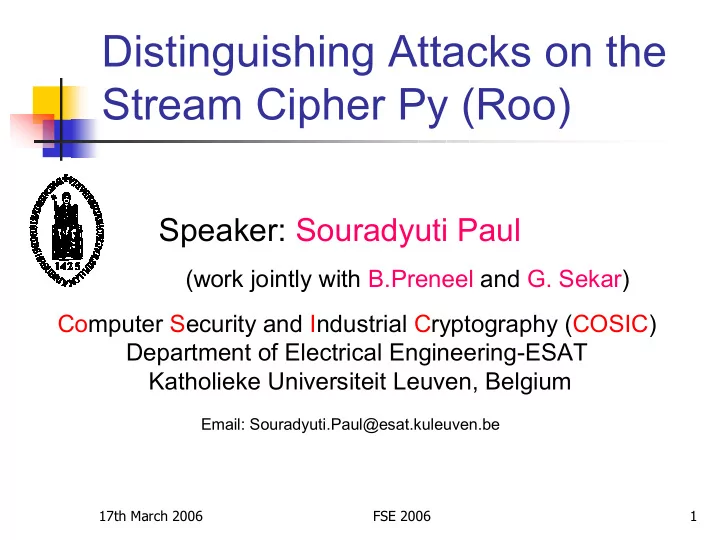

Distinguishing Attacks on the Stream Cipher Py (Roo) Speaker: Souradyuti Paul (work jointly with B.Preneel and G. Sekar) Computer Security and Industrial Cryptography (COSIC) Department of Electrical Engineering-ESAT Katholieke Universiteit Leuven, Belgium Email: Souradyuti.Paul@esat.kuleuven.be 17th March 2006 FSE 2006 1
Outline � Py and a Short History � Description of Py � Basic Idea of Attack and Assumptions � Observation: Input-Output Correlation � The Bias and the Distinguisher � Complexities of the Attack � Biases in other Pairs of Bits � Conclusions and Remarks 17th March 2006 FSE 2006 2
Py and the evolution of RC4 � RC4 (1987) by Rivest � IA, IB, ISAAC (1996) by Jenkins Jr. � RC4A (2004) by Paul and Preneel � VMPC (2004) by Zoltak � HC-256 (2004) by Wu � GGHN (2005) by Gong et al . � Py, Py6 (2005) by Biham and Seberry � PyPy (2006) by Biham and Seberry 17th March 2006 FSE 2006 3
Stage I : Key/IV set-up of Py s Key Key/IV set-up Algo 32 bits 256 bits (Step 1) IV P 128 bits 256x8 bits P 256x8 bits Y Y 260x32 bits 260x32 bits Initialization 17th March 2006 FSE 2006 4
Stage II : Keystream bytes generation of Py Round 2 Round 3 Round 1 s s’ s’’ mixing mixing mixing P P’ P’’ . . . Y Y’ Y’’ Output 1 Output 2 Output 3 XOR XOR … Plaintext 2 Plaintext 1 Ciphertext 2 … Ciphertext 1 17th March 2006 FSE 2006 5
Single round of Py: ith round 000 000 001 001 002 … 093 … 094 094 095 095 096 … 253 … 254 254 255 255 P 165 233 233 113 001 113 001 … 093 ... 233 093 079 165 079 … 096 ... 096 143 165 143 0 255 -3 -3 -2 -2 -1 -1 … … 094 094 095 095 … … 256 256 Y X’ X Y Y Z M Z M … … N P P F … Q L X’ L O(1,i) O(2,i) 17th March 2006 FSE 2006 6
The basic idea of our attacks and assumptions � Assumption: Key/IV set-up is perfect � Focus: mixing of bits in a round � Identify: a class of internal states introducing bias in the outputs � Observe: rest of the states do not cancel bias (reason: rigorous mixing) � Conclude: output is biased on a randomly chosen internal state 17th March 2006 FSE 2006 7
Main observation: A lucky case in the array P … 26 … 72 … 116 … 208 … 239 … P 1 Round 1 … 26 … 72 … 116 … 208 … 239 … X -18 Y P mod32 Round 2 … 26 … 72 … 116 … 208 … 239 … P Y+1 7 254 X+1 mod32 8 Round 3
Outputs at 1 st and 3 rd rounds Bias in the lsb’s. z=O(1,1)[0] XOR O(2,3)[0] P(z=0)=1 -3 -2 -1 0 1 … … … 254 255 256 Y G H H G Round 1 Round 2 Round 3 O(1,1) = (S XOR G) + H O(2,3) = (S XOR H) + G 17th March 2006 FSE 2006 9
Quantifying the bias � The lucky case L occurs with prob. 2 -41.9 � For the lucky case the P(z=0|L)=1 � For the rest of the cases, we observe that P(z=0|L’) =1/2 (see the paper) � The overall prob. P(z=0) =½·(1+ 2 -41.9 ) 17th March 2006 FSE 2006 10
The distinguisher (I) Biased Output z Key/IV Py n … … � Optimal Distinguisher: If # of 0’s ≥ # of 1’s then Py else Random � The advantage is close to 0% for n=1 � If n=2 84.7 then advantage is more than 50% 17th March 2006 FSE 2006 11
The distinguisher (II) � Requirements: � # of Key/IV’s = 2 84.7 � key stream per Key/IV=24 bytes � time = 2 84.7 · T ini � The distinguisher works � within Py specifications � with less than exhaustive search 17th March 2006 FSE 2006 12
The distinguisher (III) � A variant of the distinguisher works in a single keystream but takes longer outputs than specified 2 64 � To reduce work load, a hybrid distinguisher with many key/IV’s and less than 2 64 output bytes per Key/IV is also possible within the scope of the Py specification 17th March 2006 FSE 2006 13
Bias in other pairs of bits O(1,1) = (S XOR G) + H O(2,3) = (S XOR H) + G Bias in the ith bits. z=O(1,1)[i] XOR O(2,3)[i] P(z=0)=1/2+µ 17th March 2006 FSE 2006 14
Conclusion and remarks � Latest News: Paul Crowley reduced the workload of the distinguisher to 2 72 by combining all the individual biased bits � The modified version PyPy certainly does not contain this weakness � A completely unsubstantiated personal opinion: PyPy may come under distinguishing attack with workload less than exhaustive search 17th March 2006 FSE 2006 15
Thanks. 17th March 2006 FSE 2006 16
Recommend
More recommend